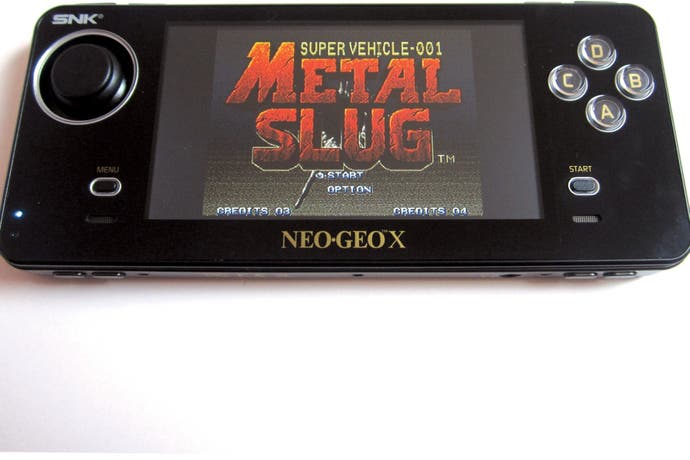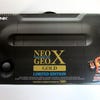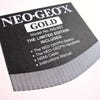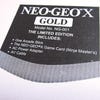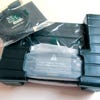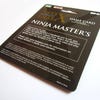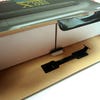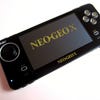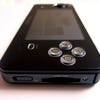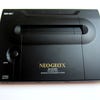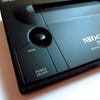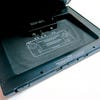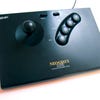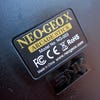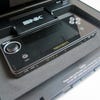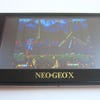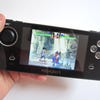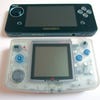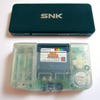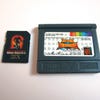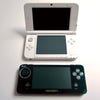Neo Geo X review
Digital Foundry finds out if this pocket-sized arcade system lives up to the legend.
Released at a time when gaming was dominated by consoles like the 8-bit NES and 16-bit Mega Drive, SNK's Neo Geo system was both powerful - and expensive. Launched in two flavours - MVS for arcade, AES for the home - the system offered coin-op quality visuals at a time when domestic gamers made do with pared-down arcade ports. The catch was the price - the console itself was a significant investment, while the games retailed for anything between £150-£200 a piece.
Predictably, this relegated the machine to little more than a bit-part during the epic console wars of the early '90s, yet the mystique of the hardware endured regardless, thanks largely to extensive coverage in the magazines of the period. Titles like Fatal Fury 2 and Metal Slug were spoken about in hushed, reverent tones in playgrounds all over the world; this was a system that was on everyone's wish list, yet for the vast majority of players it was frustratingly unobtainable. The Neo Geo's cult status has remained constant, despite the passage of time and relatively low hardware sales and the format continues to enjoy limited developer support even to this day - something that is made possible by an incredibly active and passionate community.
Were it not for the Neo Geo's unique status in the world of video games, a product like the Neo Geo X simply wouldn't exist. This is a device which has been produced to scratch an itch that many gamers have had since 1990 - the yearning to own what was once referred to as "the Rolls Royce of video game consoles". The fact that your average smartphone is far more powerful - and probably perfectly capable of emulating the SNK hardware with little effort - is irrelevant; like no other brand in the realm of interactive entertainment, the Neo Geo is blessed with an appeal dedicated players seem to find irresistible.
Of course, SNK isn't the same company it was when it pushed the Neo Geo hardware onto the marketplace over two decades ago. Bankrupted in 2001, the SNK name was resurrected as SNK Playmore and is now focused on software production. As a result, the Neo Geo X is a device created under license from SNK Playmore by American publisher Tommo and distributed in the UK by Blaze. Despite its licensed nature, the device does a fantastic job of feeling suitably authentic. The team behind the Neo Geo X's packaging clearly know their stuff; the box design is an almost identical replication of the original Neo Geo AES packaging, right down to the individual internal boxes with their contents marked clearly on the front. They've even reproduced the iconic Neo Geo logo stickers to seal each box.
When it comes to the actual device itself, initial impressions remain positive. The Neo Geo X console is well-made and has a pleasing heft to it; it's around the same size as a PS Vita and boasts a rubberised back to increase grip during gameplay. The micro-switched joystick calls to mind the example seen on the Neo Geo CD controller and the smaller variant on the Neo Geo Pocket - SNK's ill-fated attempt to go up against Nintendo's dominant Game Boy from 1998. It also emits an incredibly loud clicking noise during use, so expect to receive plenty of disgruntled glances if you plan on playing this on public transport. Still, it's entirely likely that you'll be too engrossed to notice - the degree of control and precision offered by the stick is sublime, making it blissfully easy to pull off special moves in The King of Fighters '95, or shake off the attentions of a rival player in Super Sidekicks.
The four face buttons are responsive and not too spongy but the four shoulder buttons are less impressive - they sit awkwardly in the casing and are hard to press during play. Mercifully, all Neo Geo games rely on a four-button control setup, so you'll rarely need to press the shoulder buttons anyway. They're used for peripheral controls, such as pausing the game or adjusting the screen aspect ratio - the latter being something you'll want to do almost immediately, as the default setting bizarrely stretches the 4:3 image to fit the 16:9 display, resulting in a distorted and thoroughly unattractive image. As far as we're aware all Neo Geo titles operate in the 4:3 aspect ratio anyway, so quite why we've been given a widescreen LCD in the first place is a bit of a mystery - it's entirely at odds with the requirements of the games. We can only assume that widescreen displays are cheaper to source these days and that's unfortunate - the screen is the Achilles' heel of this device.
"Well-built with sublime controls, the Neo Geo X is a lovely piece of kit but it's a real shame that the display disappoints with poor image quality. The use of a 16:9 screen for a system built around 4:3 gaming is also bizarre."
The moment you look at the Neo Geo X's display is the first time you'll feel that unwelcome twinge of uncertainty about the new hardware. The 480x272 display is terrible when compared to the screens seen on even the cheapest smartphones; it's washed out, it has terrible viewing angles and poor scaling makes all of the games included with the system look fuzzy and ill-defined. This is largely because the Neo Geo's standard resolution of 320x224 is expanded to fill the screen - it would have made more sense to pick a display which matched the resolution exactly, although we can appreciate that when using off-the-shelf parts this isn't always an option. The stretching process results in more than just a soupy image - when there's a lot of movement on the screen, background detail has a tendency to "ripple" oddly. This is glaringly apparent when playing the first level of Magician Lord, for example.
The Neo Geo X comes preloaded with 20 Neo Geo titles, with the selection providing the usual helping of arcade shooters, sports titles and one-on-one fighters - the latter unquestionably being the Neo Geo's genre of choice. There are some solid-gold classics on offer here though, including Metal Slug, Real Bout Fatal Fury and Samurai Shodown II but these are joined by some less-essential titles. Contra clone Cyber-Lip might have been impressive back in 1990, but it hasn't aged well. The same can be said for the hopelessly shallow King of the Monsters, and the lacklustre side-scrolling brawler Mutation Nation. These were not considered classic releases back in the early '90s, and today they feel positively archaic. It's clear that the initial offering of software has been selected to whet your appetite for future SD card releases - Tommo has recently confirmed that Neo Geo X Classics: Volume 1 will launch in April and will provide 15 additional titles, including the likes of Blazing Star, The Last Blade 2 and Samurai Shodown 3. Bundled with the Gold package is a copy of Ninja Master's (grammatical error and all) which comes blister-packed with no instructions.
Given that most mobile devices are connected to the web in some form these days, the notion of delivering future games by SD card - even in bundles of 15 games a piece - seems depressingly outdated. Surely it would have made more sense to connect the Neo Geo X to an online store via WiFi, or even via PC with a USB hook-up? The convenience of having 20 titles pre-loaded is mitigated by the fact that future games will need to be carried around with you at all times. While it's possible that Tommo and SNK Playmore have chosen to physically distribute software instead of taking the online route to keep things "authentic", a more obvious reason is the desire to cut hardware production costs by not giving the Neo Geo X any wireless connectivity.
"The fan service in the hardware design is untouchable: the arcade stick feels good and the docking station - shaped like an AES console - looks lovely."
Despite the official license, there's no pint-sized Neo Geo hardware contained within this handheld's dainty frame. Instead, you're getting emulated versions of SNK classics - and that predictably leads to a few inconsistencies. Screen-tearing is the biggest problem; it's present in quite a few of the games, and is especially prevalent in horizontal shooter Last Resort. The replication of audio is also hit-and-miss - long-time fans of the console will notice immediately that certain sound effects are off, and memorable tunes don't sound quite like they used to. The use of emulation has been confirmed by a recent teardown of the system, which also reveals that the data is contained on a MicroSD card with no copy protection whatsoever. Predictably, the Neo Geo X has already been hacked to run other games.
Battery life is depressingly poor when you consider that the Neo Geo X is simply emulating a console from twenty years ago. You'll get around three to four hours of gameplay from a single charge, which severely limits the console's viability as a product you'll want to take out of the house. There's also the issue that the battery is non-removable, so you can't carry a spare - and furthermore, once the battery reaches the end of its lifespan you're effectively left with a moderately attractive lump of plastic. While this is common practice with smartphones and even portable consoles like the PS Vita, it feels like a horrendous oversight in a product which was presumably created with long-term collectability in mind.
In this limited edition Gold pack, you not only get the Neo Geo X handheld, but a docking station which imitates the look of the original AES console. This features a flip-up lid which reveals docking connections for the Neo Geo X itself. When inserted and connect to the mains, this arrangement allows you to use the system as you would a traditional home console - there's even a replica of the imposing Neo Geo AES arcade stick, which, according to Tommo, has been produced to the exact specifications of the original. That's a bold claim that almost rings true; the stick is certainly as robust and responsive as its direct ancestor, but it feels slightly lighter. It connects to the docking station via a USB lead, which means you can also use it on your PC, PlayStation 3 or Android device.
"The problem with the docking station again concerns image quality - both HDMI and AV outputs produce disappointing results that don't make the best of the sublime 2D art many Neo Geo titles feature."
Included in the box are an HDMI lead and composite AV cable. Curiously, in the instruction manual Tommo recommends the AV output, but in reality neither option really offers a massive degree of satisfaction. Over HDMI, the image possesses a depressingly muddy image quality. Composite AV is even worse, with colour bleed and a dreadful hazing effect on certain games. If you've previously owned an AES system and enjoyed the benefits of RGB SCART output, you're going to be sorely disappointed with the Neo Geo X - but newcomers will possibly be more forgiving.
Neo Geo X: the Digital Foundry verdict
It's wonderful that the Neo Geo name still carries enough cachet to ensure that a product like the Neo Geo X makes it to market. Only the most blinkered fan would argue that the SNK's console was anything but a niche offering back in its heyday, but it was treated with such respect by players that its influence and fame went beyond its relatively limited installed base. Tommo respects the brand to a certain degree, taking steps to ensure the packaging and overall look is a close as possible to the real thing and offering excellent controls.
Unfortunately, despite the lofty price point of £175, the Neo Geo X is a bundle of compromises. The biggest offender is that washed-out screen, which lacks brightness and clarity, robbing the lush hand-drawn 2D visuals of their original brilliance. Emulation is effectively full-speed, but issues relating to screen-tearing and inaccurate audio sully the experience. Also, many of the games that come installed on the device are unlikely to keep you entertained for more than a few minutes.
Ultimately, if you truly want to experience this most esteemed of hardware platforms and you have almost £200 to burn, you're probably better off picking up a second-hand AES console online. Neo Geo systems are built to last, and although many AES games fetch silly prices (the AES edition of Metal Slug is worth around £1500) it's possible to pick up many common titles for less than £50.
"As much as we wanted the Neo Geo X to be a success, it sadly falls down in too many important areas to be a recommended purchase: the emulation isn't quite good enough and image quality disappoints."
This method not only ensures the most authentic experience, but also provides the best image quality - and you won't have to endure ropey emulation. You naturally lose the portability element, but with such poor battery life, the Neo Geo X can hardly be seen as truly viable mobile gaming platform anyway. A second-hand PSP with a copy of SNK Arcade Classics (or with Neo Geo games downloaded from PSN) is a better alternative if you really want to experience the best of SNK's coin-op gems in mobile form.
As much as we wanted the Neo Geo X to be a success, it sadly falls down in too many key areas to be a recommended purchase. Hardcore fans will baulk at the poor screen and unimpressive quality of the picture when connected to a television, while those with just a passing interest in the illustrious history of SNK will no doubt be dissuaded by that massively optimistic retail price.
If Tommo can ensure continued support for the device in terms of new software at sensible pricing, the Neo Geo X could have a future, but it's impossible to overlook the system's inherent shortcomings. This is a console which has been created with the right intentions but the execution is sadly lacking.
